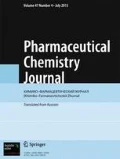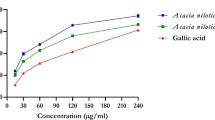This study was aimed to evaluate in vitro total content of polyphenols and flavonoids and in vivo antioxidant effect of the hydroalcoholic extract of Carduus acanthoides L. as compared to that of Vaccinium myrtillus L. The total content of polyphenols and flavonoids was evaluated by a spectrophotometric method. The chemical composition of plant extracts was determined using thin-layer chromatography, HPLC, and GC-MS techniques. Tests for the antioxidant activity were performed using streptozotocin-diabetic adult Swiss albino mice distributed in four groups, including three control groups – mice with normal pancreatic function (group I), diabetic mice (group II), and diabetic mice treated with V. myrtillus extract recognized for its antioxidant effect (group IV) – and the test group of diabetic mice treated with C. acanthoides extract at 150 mg/kg b.w. (group III). At the end of experiments, the animals were sacrificed and the activities of superoxide dismutase, glutathione peroxidase, and glutathione reductase were tested, the level of lipid peroxides was determined, and a histological analysis of the pancreas was performed. Both plant extracts contain polyphenols and flavonoids in significant amounts due to which they have antioxidant properties. The antioxidant enzymes exhibited higher activities in mice treated with C. acanthoides extract, but the level of lipid peroxides was significantly lower in mice treated with V. myrtillus extract.





Similar content being viewed by others
References
World Health Organization: The Top 10 Causes of Death, WHO (2014).
Y. Handelsman, J. I. Mechanick., L. Blonde, et al., American Association of Clinical Endocrinologists Medical Guidelines for Clinical Practice for Developing a Diabetes Mellitus Comprehensive Care Plan, Endocr. Pract., 17 (Suppl. 2), 1 – 53 (2011).
P. R. Preedy (Ed.), Diabetes: Oxidative Stress and Dietary Antioxidants, Academic, London (2014), Vol. 1, pp. 3 – 64.
E. Szaleczky, J. Prechl, J. Fehér, et al., Postgrad. Med. J., 75(879), 13 – 17 (1999).
M. Habanova, M. Haban, M. Schwartzova, et al., JCEA, 14(3), 1210 – 1219 (2013).
A. N. Singab, F. S. Youssef, and M. L. Ashour, Med. Arom. Plants, 3(1), 151 (2014).
A. Berbecaru-Iovan, C. E. Stanciulescu, S. Berbecaru-Iovan, et al., Farmacia, 62(6), 1072 – 1081 (2014).
http: // en.wikipedia.org / wiki / Carduus acanthoides
G. Aktay, D. Deliorman, E. Ergun, et al., J. Ethnopharmacol., 73(1 – 2), 121 – 129 (2000).
M. Kozyra, A. Biernasiuk, and A. Malm,, Acta Polon. Pharm. Drug Res., 74(1), 161 – 172 (2017).
I. Orhan, D. D. Orhan, and B. Özçelik, Food Chem., 115(2), 701 – 705 (2009).
W. Chu, S. Cheung, R. Lau, et al., Bilberry (Vaccinium myrtillus L.) in: Herbal Medicine, Biomolecular and Clinical Aspects, 2nd edition, CRC Press, Boca Raton (2011), pp. 55 – 72.
Farmacopeea Românã, Xth Edition, Medicalã, Bucureşti (1993), pp. 921 – 922, 983 – 989, 1019 – 1021, 1051 – 1055.
R. Borneo, A. E. León, A. Aguirre, et al., Food Chem., 112(3), 664 – 670 (2009).
L. Silva, B. R. Pezzini, and L. Soares, Pharmacogn. Mag., 11(41), 96 – 101 (2015).
H. Lichtenthaler and A. Wellburn, Biochem. Soc. Trans., 11(5), 591 – 592 (1983).
R. M. Varut and L. T. Rotaru, Rev. Chim. (Bucharest), 68(2), 228 – 231 (2017).
I. Chinou, Herbal drugs and the role of chromatographic methods in their analysis, in: M. Waksmundzka-Hajnos and J. Sherma (Eds), High Performance Liquid Chromatography in Phytochemical Analysis, CRC Press, Boca Raton (2010), Vol. 2, pp. 3 – 12.
V. Rădulescu, M. Pavel, and E. Oprea, Rev. Roum. Chim., 52(12), 1115 – 1122 (2007).
H.Wagner and S. Bladt (Eds.), Plant Drug Analysis: Thin Layer Chromatography Atlas, 2nd edition, Springer, Berlin – Heidelberg (1996), pp. 44, 45, 70, 71, 118, 119, 132, 133, 144, 145.
S. P. Nair, N. C. Shah and R. M. Shah, Biomed. Res., 23(3), 402 – 404 (2012).
S. Lenzen, Diabetologia, 51(2), 216 – 226 (2008).
S. Sandler and L. Jansson, Virchows Arch. A: Pathol. Anat. Histopathol., 407(4), 359 – 367 (1985).
A. Berbecaru-Iovan, A. M. Andrei, A. C. Nicolae, et al., Farmacia, 64(5), 722 – 727 (2016).
U. Asmat, K. Abad, and K. Ismail, SPJ, 24(5), 547 – 553 (2016).
Y. Dincer, T. Akcay, and Z. Alademir, Mutat. Res., 505(1 – 2), 75 – 81 (2002).
B. K. Tiwari, K. B. Pandey, A. B. Abidi et al., J. Biomark., article ID: 378790 (2013).
S. Surya, A. Dhaliya Salam, D. V. Tomy et al., APJTD, 4(5), 337 – 347 (2014).
L. Rochette, M. Zeller, Y. Cottin, et al., BBA General Subjects, 1840(9), 2709 – 2729 (2014).
S. Oancea and L. Oprean, Food Technol., 15(1), 1 – 13 (2011).
S. K Sharma, S. Lalit, and S. Suruchi, IJRPB, 1(3), 404 – 409 (2013).
R. Li, S. Liu, W. Song, et al., Anal. Methods , 6, 7181 – 7189 (2014).
Author information
Authors and Affiliations
Corresponding author
Rights and permissions
About this article
Cite this article
Varut, R.M., Gîrd, C.E., Rotaru, L.T. et al. Evaluation of Polyphenol and Flavonoid Profiles and the Antioxidant Effect of Carduus Acanthoides Hydroalcoholic Extract Compared with Vaccinium Myrtillus in an Animal Model of Diabetes Mellitus. Pharm Chem J 51, 1088–1095 (2018). https://doi.org/10.1007/s11094-018-1746-0
Received:
Published:
Issue Date:
DOI: https://doi.org/10.1007/s11094-018-1746-0




